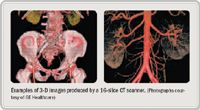Article
No reconstruction modality for PCNL is perfect
Amsterdam, Netherlands--Three-dimensional computed tomography reconstruction of the pelvicalyceal system helps in the planning and execution of percutaneous nephrolithotomy, but the relative value of each reconstruction method is not known.
Amsterdam, Netherlands-Three-dimensional computed tomography reconstruction of the pelvicalyceal system helps in the planning and execution of percutaneous nephrolithotomy, but the relative value of each reconstruction method is not known.

The investigation involved the scanning of seven patients (five men, two women) scheduled for renal stone surgery using a 16-slice CT scanner (Lightspeed 16, GE Healthcare, Waukesha, WI). The patients acquired contiguous prone renal scans of 2.5-mm slice thickness before and after IV contrast, diuretic, and saline with 10-minute delay.
The investigators noted that the stone load was best visualized on non-contrast SR images. They could best assess the uteropelvic junction and infundibular width on contrast MIP. Compared with MIP, VR and SR underestimated infundibular width by 6% to 17% and 8% to 15%, respectively.
Contrast VRi and VRm produced the greatest calyceal detail, and all stones were well delineated from the contrast. Compared with VR, contrast SR underestimated the number of calyces seen by 10%. Overall, the researchers rated VRm the most useful for planning (median score, 5).
The investigators revealed that with MIP, they could visualize structures of maximal density, ie, stones. MIP's disadvantage was that depth perception was poor (essentially a 2-D coronal perception). Compared with IVU images, the researchers observed that MIP showed stones more clearly.
VRi was done with a corresponding IVU. VRi depicted both soft and hard tissues in true 3-D format with good perspective, the researchers said. In one patient, the procedure led to a supra 11th rib puncture onto the upper pole.
The 360-degree rotating MPEG movie, centered on the spine, can be played on any standard computer. It provided a global feel for anatomy, the investigators said.
The study revealed that SR (non-contrast), while only using 10% of available data, showed stones and high-density structures well. There was no soft tissue information. Its advantage over MIP was that it showed volume relationships. In one patient, SR visualized two lower pole calculi better and another solitary calculus that KUB missed.
Clinical usefulness
Surgeons in the audience were interested in the extent to which the researchers believed that the trial results would affect decision making in the future.
"The 3-D reconstructions that are possible with the latest 16-slice CT scanner provide information far superior to IVU, and we predict that reconstructions planned with a movie will become the standard planning tool prior to PCNL," said first author Khurshid Ghani, MD, an endourology research fellow at St. George's Hospital, working with Ken Anson, MD.
He explained that the surgeon worked very closely with a radiologist (Uday Patel, MD), first assessing the IVU series and then the reconstructions. The reconstructions inevitably led to changes in the original PCNL plan.
Dr. Ghani observed that the reconstruction series showed almost too much information, at times, turning what might have been a simple procedure into something more complex. Sometimes, knowing more is not better, he said.
Newsletter
Stay current with the latest urology news and practice-changing insights — sign up now for the essential updates every urologist needs.





